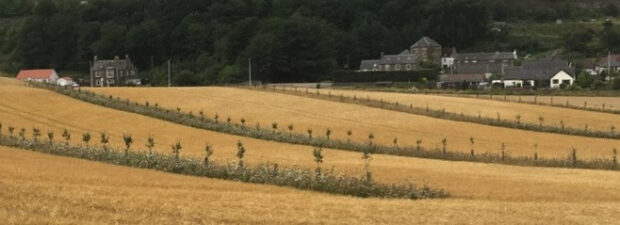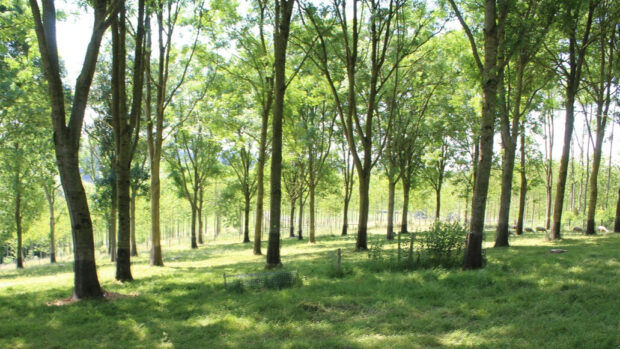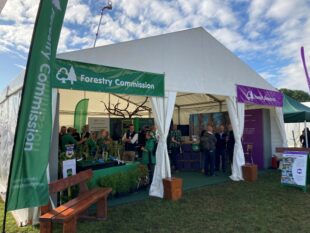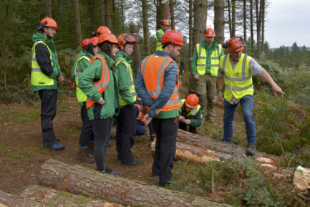 Jim O'Neill, Agroforestry Development Manager, shows how applying traditional forestry knowledge to agroforestry systems can unlock timber production potential. In this blog, Jim dives deeper into the topics that will be covered at the Agroforestry Show in September.
Jim O'Neill, Agroforestry Development Manager, shows how applying traditional forestry knowledge to agroforestry systems can unlock timber production potential. In this blog, Jim dives deeper into the topics that will be covered at the Agroforestry Show in September.
Ten years ago, agroforestry – the practice of integrating trees into a farm’s land use – was a little-known concept in the agricultural world. Since then, knowledge and interest in planting trees on farms has grown rapidly.
At the Forestry Commission, we have a growing team of Agroforestry Woodland Officers, who are becoming regular faces at farming events and shows across England.

Agroforestry integrates trees into farming systems and when well-planned and managed, can maintain or enhance existing agricultural output.
Think of it as three-dimensional farming, where the third dimension – the trees – can add to the yield directly through timber, fruit and nuts, or by providing shade and shelter that helps increase crop yields and livestock performance.
While agroforestry is often considered for the benefits trees provide to your land, crops and livestock, trees can do much more – they can produce a valuable crop themselves.
This is where forestry expertise becomes crucial: growing high-quality timber requires specific knowledge and skills that the forestry sector can provide.

Turning to timber
As agroforestry gains popularity, many are asking an obvious question: could these trees also produce quality timber? The answer is yes but it requires knowledge and skill, and the kind of expertise that forestry professionals have developed over decades. You could say it’s about putting the forestry back into agroforestry.
Quality timber production isn’t something that happens by accident. It requires careful planning and ongoing management throughout the tree’s life cycle: from establishment and protection through to pruning and harvesting. Each of these stages needs thoughtful consideration when designing a new agroforestry system.
As with any good farming or forestry decision, success depends on matching your approach to your specific conditions. Your soil type, land aspect and the climate will influence species choice, how densely to plant trees and what’s practical for you and your farm. Budding agroforesters need to think strategically about integration: will you grow crops between rows of trees, or graze livestock under or amongst them?

Planning and managing your vertical crop
Species selection for maximum value
Successful timber agroforestry requires strategic species selection. Different tree species offer varying timber values and growth characteristics, so there are various options that can align with your farming system and local markets.
For example, wild cherry can yield high-value timber for furniture and joinery, reaching maximum height within 20-50 years and yielding fruit within 5-6 years. For detailed information on species selection and management techniques, Forest Research’s Tree Species Guide for UK Agroforestry Systems provides comprehensive guidance on species best suited to farms.
Protecting your crop from mammals
Farmers and foresters alike are familiar with the threats posed by mammals such as deer and grey squirrels. Managing mammals is particularly critical in agroforestry systems, where lower tree densities mean the loss of individual trees has a greater potential impact than in traditional forestry.
An important first step is to conduct a baseline assessment to understand the risk or current level of impact mammals could have on your trees. This will allow you to put appropriate mammal management in place across your site. Then early adoption of protection measures is essential to minimise damage and ensure success of your agroforestry project.
Adapting forestry techniques
Managing your ‘vertical crop’ requires adapting standard forestry techniques for the unique demands of integrated farming systems.
High pruning is a key technique which involves systematically removing lower branches to create clean stems and an elevated canopy. This serves three purposes: producing valuable knot-free timber, allowing light to reach the crops below, and providing clearance for farm machinery to easily pass underneath.
Harvesting an agroforestry timber crop
Agroforestry aims to maintain the benefits that the trees bring over time, which means harvesting can look different than it does in traditional forestry.
Instead of clear-felling large areas, consider methods like selective felling and continuous cover forestry. These involve removing smaller numbers of carefully chosen trees while preserving the overall tree canopy.
By harvesting individual trees or small groups, you can maintain essential benefits like shelter, biodiversity and soil protection, while still generating an income. It also creates space for replanting keeping your system both productive and resilient.
Timber from agroforestry offers farmers another route to diversification and builds business resilience. However, success depends on honest assessment – do you have the capacity to carry out the work, and can you find reliable markets for your products?

Building agroforestry skills for the future
The forestry expertise needed for quality timber production in agroforestry systems isn’t just valuable today, it’s essential for the future. As agroforestry grows, so does the need for training and education, though skill gaps remain a barrier to wider adoption.
There are promising developments. Agroforestry is beginning to appear in university courses, from guest lectures at Harper Adams to dedicated postgraduate programmes like Bangor University’s MSc in Agroforestry and Food Security. The Soil Association also offers an e-learning module on agroforestry and farm woodlands.
Looking ahead, there’s growing momentum to embed agroforestry into formal education and advisory services. This will ensure the next generation of farmers, advisors and land managers are equipped to confidently integrate trees into productive landscapes. Meanwhile, peer-to-peer learning through networks like the Farm Woodland Forum offer practical ways for farmers and landowners to share knowledge and experience.

Getting started with agroforestry
For those looking to integrate trees into your farm, get in touch with your local Agroforestry Woodland Officer through our contact form. They can offer advice and guidance to get you started.
If you have existing woodland, understanding the condition of your existing trees can help you dip your toe into forestry and harvesting timber. Start by assessing your current trees through the Woodland Condition Assessment app. It’s a practical first step to bring your trees and woodland into management.
Find out more information on our guide to agroforestry GOV.UK page.
Come and talk to our Agroforestry Woodland Officers at the Agroforestry Show on Wednesday 10 and Thursday 11 September 2025. Find us at the Natural England Stand or in the Advice Hub.
We’ll cover topics from this blog in our sessions and host advice surgeries where you can get personalised guidance.


